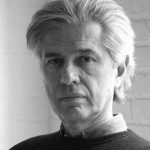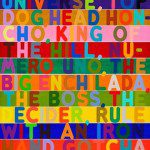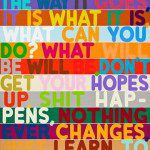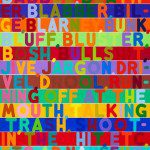‘Amazing!’ Mel Bochner in the Tower
By • May 3, 2012 0 2227
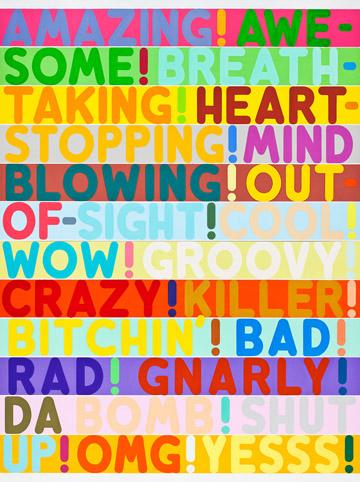
An art professor once gave me a great piece of advice: “Whenever you look at a work of art,” he said, “always ask yourself one question: What is it?” It is with this unimpressive mantra that I walk into every museum and approach every exhibit. For whether I am looking at a Titian mural (a portrait) or one of David Smith’s twisting metal sculptures (an abstract), this process helps me define the parameters of the artwork and experience things evenly and honestly. But entering the Tower of the National Gallery of Art to see the recent exhibition of Mel Bochner, I was at a loss for definition. Ironically enough, it was a room full of words.
In the mid- to late 1960s, Bochner created a series of portraits of friends and colleagues using only words written on paper, assembled and organized largely through studying Roget’s Thesaurus. One of the founding fathers of conceptual art, Bochner has spent his career questioning the nature of the art object, focusing on process, perception and idea over—and often in lieu of—the usual conclusion of artistic practice: a physical work of art.
For example, his Measurement series used black tape to make measurements directly onto walls, effectively making large-scale diagrams of the rooms in which they were installed. But through making and compiling words, Bochner found a depth, eloquence and historical context uniquely suited to his palette—and what he perhaps never found in the standard definition of painting. Bochner would not paint a portrait. He would paint: “Portrait, Depiction, Archetype, Likeness, Model, Effigy.”
“The thing about English that’s so fascinating as a language is its ultimate flexibility,” Bochner says. “One thing about the thesaurus is that they always add words but rarely eliminate things. So you get an archeology of language.”
This is the foundation of Bochner’s recent work, a rather idiosyncratic history of English. His earlier words-based works were meant to be portraits, as well as erudite studies in the flaws, redundant coextensions and contradictions of English. His new work, the primary focus of this exhibition, has taken the form of borderline social activism, revealing an ever-evolving lexicon where “Amazing” is replaced by “OMG,” and “Screw the Pooch” has eclipsed “Perish.” It also reveals more than a few of the artist’s bugbears, philosophical and moral uncertainties, and the result is a remarkably naked, honest and fulfilling experience.
It had been over 30 years since Bochner made—or even looked at—his initial thesaurus series. But when he reexamined the drawings for a retrospective of his work at Yale in 1995, “My response was, there’s probably more juice in that lemon—probably worth another squeeze.”
The first new word-works he made were revisited portraits of Eva Hesse and Robert Smithson (both the originals and the revisited portraits are on view in the exhibition). “The earlier ones have the certitude of my youth—black ink, no mistakes,” Bochner says. “And I couldn’t go back to that anymore, it’s not my attitude toward life. So I redid them with charcoal and kept erasing and reworking and it formed a kind of bridge.”
But, as it seems, Bochner’s “attitude toward life” rapidly took to the forefront of his new work, evolving it from portraiture of the individual to portraiture of time, place and sentiment. The headlining diptychs of the exhibition, “Master of the Universe,” “Oh Well,” “Amazing!” and “Babble” are monumental paintings over eight feet tall, painted in crass neon hues with a bubbly Comic Sans-type font.
“These paintings are my response to everything I see around me,” he says. “They address the disillusion of language in terms of contemporary discourse. I look at this as basically an inarticulate expression of the underlying contradictions of the systems we live in, with a lack of articulate consciousness. And maybe it’s an educational deficit.”
The political edge of these pieces is hard to ignore. “It was very important to me to have that painting, ‘Master of the Universe,’ in Washington,” he says. “And I hope that people get, without my having to explain, the sociocultural undertones of that painting next to the other painting, ‘Oh Well.’”
“I long ago gave up on the idea that art can change capitalism,” Bochner says. “But anything that can bring people to greater consciousness about their own experience is positive and, I believe, a step in the right direction.
For instance, it is no coincidence that his painting “Amazing” begins with the words Amazing and Awesome—biblical words with which the Old Testament denoted God’s power—and then runs through the chronology of evermore contemporary exclamations, until concluding like a fart with OMG. The Awesome becomes more of a self-involved hyperbole than anything worthy of real rejoice.
“I want the paintings to be part of a conversation, a discourse,” he says. “Otherwise, why use language? The best quote I know about this is from Nietzsche: ‘We write not only to be understood, but also to be misunderstood.’ And that’s really it. To be misunderstood is to carry forth the conversation. It’s to raise questions, create arguments and disagreements. That’s basically what philosophy is. People misunderstanding each other.”
For a lifelong conceptual artist, Bochner’s new work is uncharacteristically ubiquitous, and it dances oddly around abstract expressionism and pop art. On the one hand, in answer to my self-imposed question, What is it? the answer could not be more tangible or concrete. It is words. Just like Warhol’s soup cans or Van Gogh’s purple irises, the work is inert. But a series of words cannot help but be read and, just as in abstraction, the interpretations can spin out endlessly and wildly. To quote theorist and critic Frederic Jameson, “The work…is taken as a clue or symptom for some vaster reality which replaces it as its ultimate truth.” The beauty of Bochner’s exhibition runs synonymous to the crudity of daily American life: we are free to pay as much or as little attention as we please, but there’s no denying the harsh reality before us, displayed in bold bright colors across the walls of our consciousness.
Mel Bochner’s Thesaurus Works are on view at the National Gallery through April 8, 2012. For more information visit Nga.gov/Exhibitions
- Amazing!, 2011 oil and acrylic on two canvases overall: 254 x 190.5 cm (100 x 75 in.) Courtesy Peter Freeman Inc., New York | Mel Bochner

